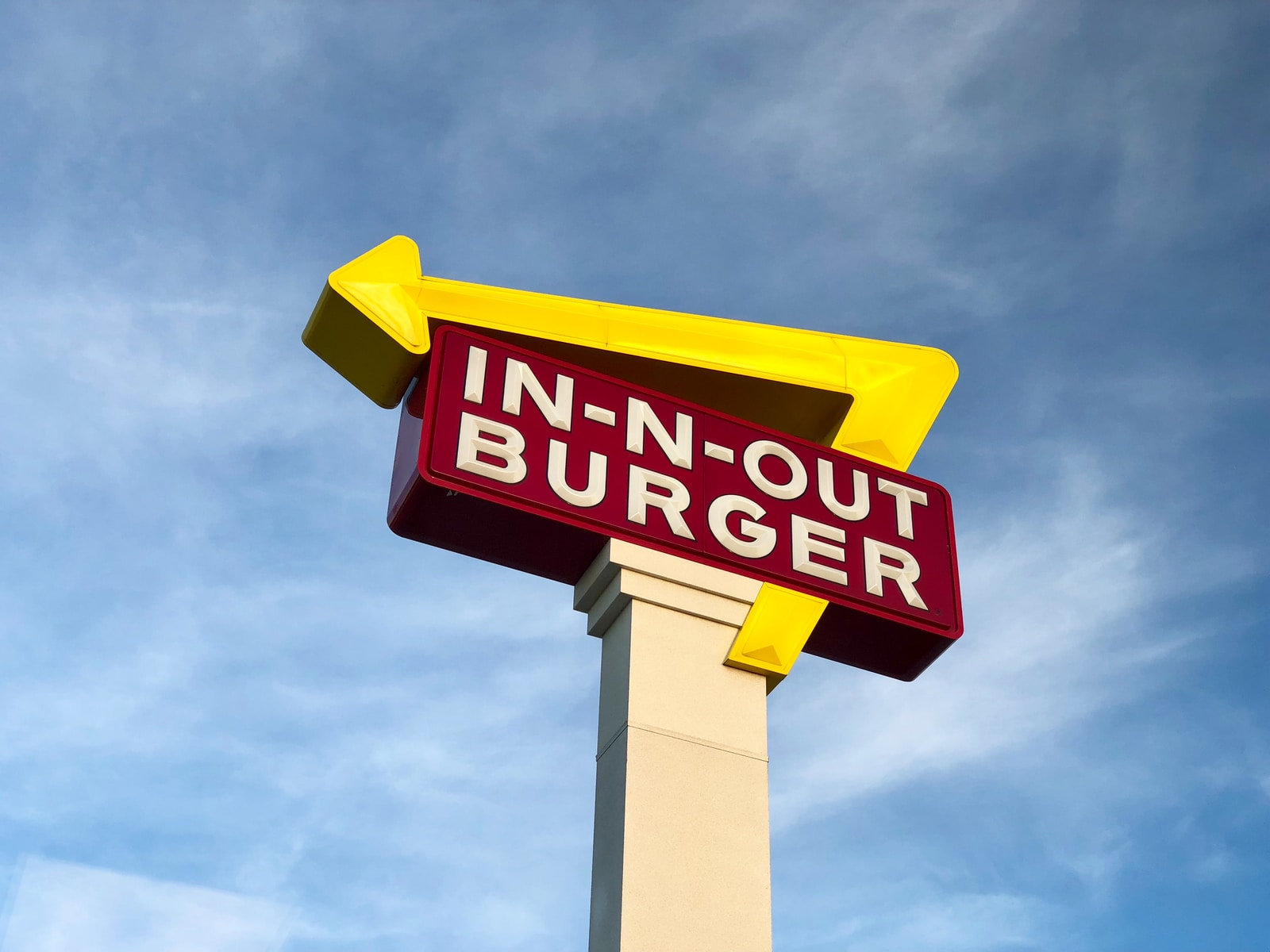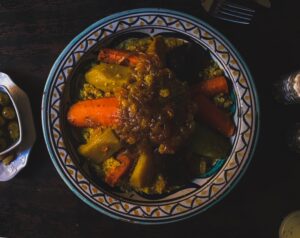Whether you are on the road, out shopping, or at CVS, I will give you guidance for situations where you have to just grab a bite or a snack on the road (for travel, please see my post here). You will be able to apply the “Little Black Dress” Method to have your go-to choice for each spot.
Whether you are on the road, out shopping, or at CVS, the DAOFitLife approach will give you guidance on nutritious choices for situations where you have to just grab a bite or a snack on the road.
This is the DAO guide to ordering on the go. Now, this doesn’t mean you can’t be spontaneous. If you see something on the menu that catches your eye and you want to try it or it satisfies a craving, go for it. That is where portion control can serve you.
Also, in some salad references, I refer to my “BYOD” method, which is essentially bringing my own low-cal dressings.
How this guide is set up
This guide is set up as follows:
PART 1: Common casual dining options—We will explore options for chain restaurants like Applebee’s.
PART 2: Fast food and drink options—We will explore options for on-the-go traditional and nontraditional fast food like Starbucks, Dunkin’, McDonald’s, Subway, Panera.
PART 3: The “Build a Bowl” options —The model of a lot of salad and ethnic food bars is the same “build-a-bowl” option, so this will be widely applicable guidance that can apply despite geographical differences.
PART 4: Convenience Options —We will explore options for places like 7-11, CVS, Walgreens, Duane Read, or gas station convenience stores. We have all been there, aimlessly staring and roaming around. Now you have the DAO to get you in and out.

Common casual dining options
Ruby Tuesday
I used to work here, so I know that the salad bar is an awesome choice.
Other than the bar, these are the choices I would recommend for lunch or dinner:
- Garden salad with protein and dressing on the side (or BYOD)(appx. 400 calories)
- Steamed broccoli or grilled zucchini sides (22 calories)
- Grilled chicken (215 calories)
- Vegetarian: Veggie burger (550 calories)
The spinach artichoke dip is delicious, but it is very high in calories and greasy, so it’s not as healthy as it sounds. A good “20” choice.
Olive garden
Ah, the breadsticks and salad! Some of this brings back memories from childhood. While Olive Garden can be a calorie disaster, there are some healthy options I would recommend, in line with suggestions from nutritionists:
- Zoodles Primavera (570 calories)
- Chicken Giardino (530 calories)
- Minestrone Soup (110 calories)
The good news about the breadsticks is that one of them does not do too much damage (it is 140 calories, half of it coming from carbs and the other from fat). And you can even have your fill of salad if you request the low-fat version of their famous dressing on the side, which only has 30 calories per serving. You can even order it online to have some of your very own (I have to say it is very close to the real deal, if only slightly a little more runny). Just don’t literally take them at face value of “bottomless” – this is where you can get on that slippery slope.
Outback Steakhouse
Outback’s menu varies by location, but in most places, lists the full calorie count for most items.
You can see that like Ruby Tuesday, the calorically expensive choices are mainly in the appetizers. Bloomin Onion, anyone? I will vouch for the fact that it is delish—you just may not want to order anything else!
Here are some of the healthier choices (note some menus are subject to change)
- Aussie Cobb Salad (160 calories)
- Bourbon Salmon or Perfectly Grilled Salmon option (600 calories)
- Brisbane Caesar Salad with Grilled Shrimp or chicken (580-640 calories)
- Grilled Chicken on the Barbie (310 calories)
- Steak: The healthiest and leanest cut of steak for Outback is the center cut sirloin (210 calories)
- Sides: Outback has sides of mixed and seasonal vegetables, as well as side salads (just watch the dressing).
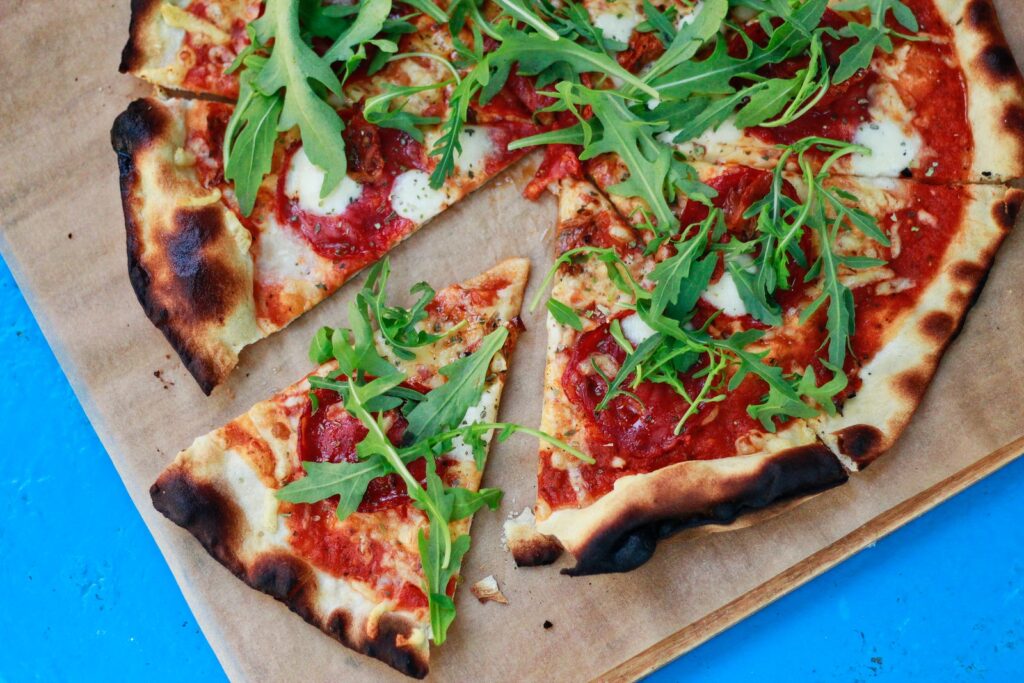
California Pizza Kitchen
Pizza has been demonized, but you can still eat pizza and be fit. Healthier pizza choices include:
- Wild Mushroom Pizza (170 calories per slice)
- California Veggie Pizza on cauliflower crust (520 calories for whole pizza)
Also ask for light cheese and/or sauce, or cauliflower crust—they will accommodate and do offer these options!
You may want to skip some of the pizzas, like the Spicy Milano Thin Crust Pizza (per slice, 240 calories).
Also, do not fall for the ‘healthy’ salads. For example, the BBQ Chicken Chopped Salad has 1180 calories and will take walking over 330 minutes to burn off. It sounds deceptively healthy, but it has a similar profile as one of the most high calorie menu items at the Cheesecake factory, the Chinese Chicken Salad, which has a whopping 1740 calories). For the same amount of calories and fat grams in these dishes, you could have a ribeye steak with mashed potatoes!
CPK also has healthy non-pizza options, like “power bowls.” Again, you have to watch what toppings they have because that can increase the range from 600-100 calories. Here are the best bowl options:
- Banh Mi Power Bowl w/ Poblano Ranch (540 calories)
- Santa Fe Power Bowl w/ Poblano Ranch (670 calories)
Finally, here are some healthier entree dishes:
- Cedar Plank Salmon (650 calories)
- Classic Caesar Salad (540 calories)
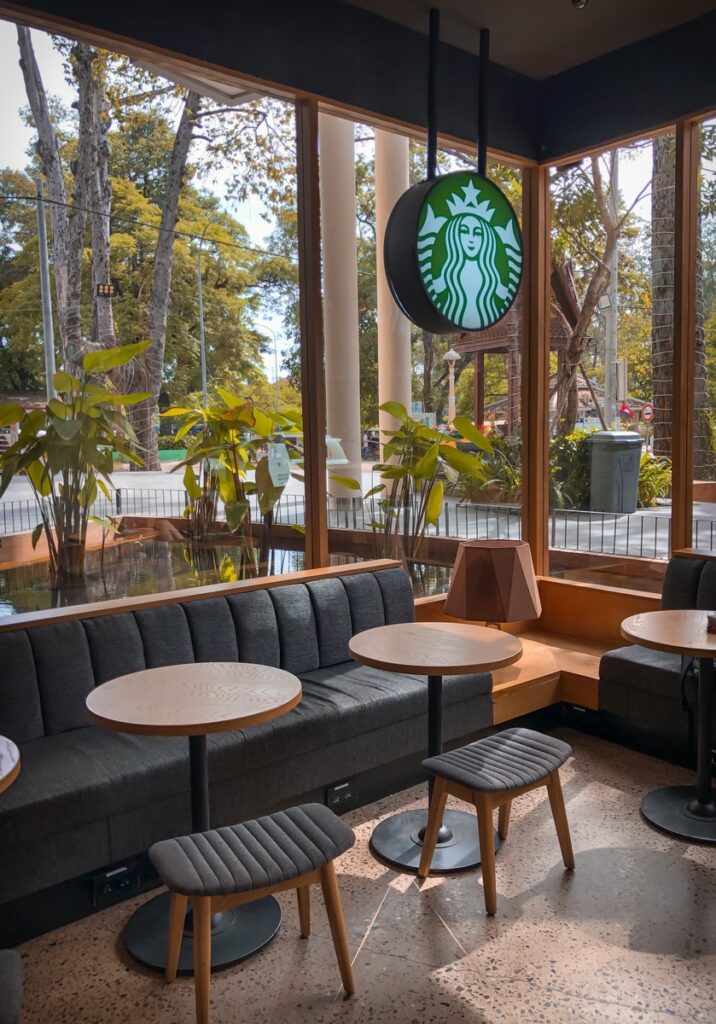
Fast Food and Drink
Starbucks
Let me start by saying categorically: I CANNOT. DRINK. BLACK. COFFEE.
If I could, I would recommend that, and this would be a very short chapter. Drink black coffee. It’s 5 calories. The end. But no, not me. I will gag. I need my coffee to be creamy. I need my tea not to taste like I am drinking freshly mowed lawn. So when I wrote this, I had all of you in mind—we want our yummy coffee and tea drinks, but if we wanted them to have 200+ calories, we’d just as well order the ice lemon pound cake. Here is a deeper dive on the do’s or don’ts of ordering at Starbucks. You can find the full nutrition menu here:
However, it does not contain some of the updated drink information. A good source to find this is at https://fastfoodnutrition.org/starbucks
Before we launch into the information, I want to clarify that some of these choices standing alone are not necessarily bad. If you have one 120 calorie drink that has a little sugar, and then eat healthy the rest of the day, that will not likely set you off track. But look at that like a “20.” The problem with these coffee drinks is not really each one alone, but the fact that most people like us who work 14-16 hour days need 2,3 coffees. So that’s when it really adds up and becomes unhealthy.
The other factor to keep in mind is the “supersize” phenomenon. The calories and other nutritional information is based on a grande size, which is 16 ounces.
The biggest problem with most of these drinks is not the calories, or the fat. It is the added sugar, in addition to the sugar that naturally occurs in most milks, including plant-based. These sugars, in combination with flavored syrups, can make your coffee a big drink of liquid candy. And if you are having more than one a day, or eating other high-sugar foods later in the day, that can be a problem. Generally anything north of 12 grams of added sugar is on the high side, to put in context while you are reading the rest of the information.
Don’t Order: Matcha green tea latte (240 calories)
A matcha green tea latte sounds healthy, right? But it clocks in at 240 calories and 32 grams of sugar!
Do order: Hot Green tea, hot green tea latte or Unsweetened iced green tea (0 calories)
If you still want a bit of foam with your green tea, get a hot green tea latte. This is kind of off-menu but the barista should understand it. It’s only going to set you back about 50 calories and 3 grams of sugar. What they do is basically make the tea still with the bag but then add a bit of foamed milk of your choice with it. It really works best with regular milk or almond milk, but not coconut milk because that gets clumpy.
Iced green tea is also a good option because it’s zero calories, and it’s blended with mint to make it less “grassy,” which is one of the primary turn-offs of green tea for many people.
Don’t order: “Skinny” lattes (120 calories, 16g sugar)
As we discussed in Chapter 13 on Nutrition labels, many of the labels at coffee shops also have misleading “halo” effects. Skinny coffee drinks at Starbucks and other places are a perfect example. I was once the queen of venti skinny caramel lattes. Even though on its face 120 calories may not seem that bad, it is still about 16 grams of sugar. And I was drinking two of these a day. Yiiiikes.
The problem with the syrups is that they usually are loaded with sugar. And even if you get the sugar-free brand, that is loaded with chemicals that make you crave even more sugar. It always comes as a cost. Plus, it tastes nasty, doesn’t it?
Nonfat milk also has a lot of sugar (it has “lactose,” one of the kinds of sugar). For example, a grande nonfat latte with no flavors has 18 grams of sugar. Add some syrup, and you can go up to 30, which is almost the same as having a regular soda.
Do order: Almond milk lattes or cafe au lait (100 calories)
OR: Order the skinny latte you but specify only 1-2 pumps to cut down the sugar. The default number of pumps is 4.
Almond milk latte grande size has 100 calories, 6 grams of fat, and 5 grams of sugar. These are better alternatives if you want a milky drink.
Almond milk is a better option than coconut milk, which has 110 calories for a grande size latte with 10 grams of sugar.
If you like real milk and are not a fan of plant-based milk, you can try an often overlooked menu item called “cafe au lait”, which is basically just coffee mixed with milk but less so than you would get in a latte. A grande cafe au lait with regular milk is only 110 calories, 4 grams of fat and 10 carbs.
Don’t order: Oat Milk, Soy Milk or Coconut milk lattes (110 calories)
The plant-based health kick continues to press on, but for those who perceive these non-dairy options as healthier, I need to wave a big stop sign. That is not a lot of calories on its face, but this comes with 6 grams of saturated fat and 10 grams, making it basically a blend of hot sugar and fat.
A Honey Oat Milk Latte (one of the popular new drinks) is 270 calories, 28 grams of sugar, 10 grams of fat for a grande!
A grande oat milk latte does not fare that much better at 190 Calories, 7 grams of sugar, 8 grams of fat.
A grande coconut milk latte is about 140 calories and about 70 calories of that comes from fat. That’s a heavy price to pay for a coffee drink, and not to mention, it contains 12 grams of sugar.
A grande soy milk latte has 170 calories, and while it has slightly less fat at 5 grams, it also has 17 grams of sugar.
If you are really attached to oat milk, soy milk, or coconut milk, order an Americano with a splash of either of these options instead of a latter. You will only get about ¼ of a cup if each at the most, which is a fractional amount of all the sugars/fats/calories listed above.
Don’t order: Regular Frappuccinos
Frappuccinos just by themselves have 230 calories and 45 GRAMS of sugar. That is just the plain coffee flavor. Without the whipped cream, syrup, or any other toppings. Even the “light” frappuccinos are packed with sugar. On occasion, I like to order a vanilla bean Frappuccino. If I do that, it is definitely a “20” choice and I do it up with all the toppings because I know this is a treat that I do not have often. It definitely should not be an everyday drink. It does not even contain that much caffeine (about half the amount in a regular coffee).
Do order: Iced shaken espresso with almond milk
You still get the icy, creamy feeling of a Frappuccino, but without all the calories. Be sure not to include the classic syrup, and sweeten with Stevia in the Raw instead.
You can also get an espresso Frappuccino with almond dairy alternative, which clocks in at around 90 calories, if you really have to have a Frappuccino.²
Or make your own if you really want that feeling of having a blended icy drink. For an awesome DIY low cal frappuccino recipe, combine:
- 1 cup Silk Unsweetened Vanilla Almond Milk
- 1 tbsp monk fruit
- 1 tbsp stevia-sweetened 5 sparrows Frappe and Smoothie base
- 2 Tbsp non-dairy creamer (like nutpods)
- Ice
- Blend and have a 50 calorie no-sugar Frappuccino instead!
Don’t order: Seasonal Flavored Cream cold brews
The Pumpkin Cream Cold Brew has 250 calories for a grande and over 30 grams of sugar! But don’t worry, you can have your cold brew and drink it too. If you make it a tall, you basically cut the calories and sugar in half. Or, for an everyday drink, try one of the Nitro options below.
Do order: Plan Nitro Cold Brew or Nitro Cold Brew with sweet cream and cold foam
A plain Nitro Cold brew only has 5 calories, and if you drink it fresh with just a little stevia, it is actually very foamy and creamy, which helps replace the texture of a cold foam without all of the extra calories. . Or, you can order a Vanilla Sweet Cream Nitro Cold Brew (note the key difference of the word “Nitro,”, which is like a light version of the other Cream cold brews above. It has 70 calories and 4 grams of sugar.
Top all-around best Starbucks drink choices
Here is a list of Starbucks orders where you can’t go wrong:
- Tall almond milk latte (80 calories);
- Hot green or herbal tea (0 calories);
- Cool lime or Strawberry Acai refresher (70-100 calories)
- Nitro cold brew – 5 calories
- Iced hibiscus tea – 0 calories
- Iced hibiscus tea with lemonade – 46 calories
- Americano with splash of half and half and stevia (40 calories)
- Tall iced shaken green tea or passion fruit herbal tea with no syrup (45-60 calories)
- Tall cold brew coffee with splash of milk of choice (20-50 calories)
Here is some guidance on the food orders at Starbucks.
Best food choices:
Breakfast:
- Eggs Sous Vide Red Pepper and Egg White (140 calories)
- Blueberry Oatmeal (no added brown sugar), add banana (250 calories)
- Spinach, Feta, and Egg wrap 280 calories)
- Low-fat Turkey Bacon English Muffin Sandwich (230 calories)
- If you absolutely must have a baked good, make it your “20” or order a blueberry bagel with cream cheese (400 calories)
Lunch or snacks:
- Chicken & Quinoa Protein Bowl with Black Beans and Greens (420 calories)
- Grilled Chicken and Hummus Protein Box (300 calories)
- Basically any of Starbucks’ “Protein Box” options are great, especially the ones with hard boiled eggs.
Dunkin’ Donuts
Like with Starbucks, you generally want to avoid a lot of fancy drink names and flavored syrups. For example, a Large French Vanilla Swirl Frozen Coffee with Cream has over 1000 calories!
For food, donuts and bagels are more “20” choices, but there are some healthier items on the menu. Surprisingly the donuts contain just slightly more calories than the bagels, and both have refined ingredients, so practically speaking, it does not really matter which you are ordering. This is information you need to know just so you do not fall into the trap of ordering bagels thinking that this is somehow a healthy alternative to a pastry or donut.
Beverages:
- Small coffee with a splash of milk of choice (almond, oat, cream, or nonfat milk)(20-40 calories)
- Hot green tea (0 calories)
- Cold brew coffee with splash of milk of choice (20-40 calories)
- Blackberry Oat Cold Brew (45 Calories)
Food:
- Avocado and Roasted Tomato Avocado Toast (260 calories)
- Veggie Egg White Omelet Sandwich (290 calories)
- Wake Up Wrap with Beyond Sausage Patty (180 calories) (the wrap is 250 calories)
- Snackin’ Bacon (190 calories)
Chick-fil-A
You probably want to pass on the regular Spicy Chicken sandwich (460 calories and 19g of fat), and the Chick-Fil-A waffle fries (420 for a small). The Grilled chicken breast sandwich is a healthier option (380 calories and 11g of fat).
An even better combo would be the following:
- Grilled Chicken Nuggets (12 pieces, 200 calories)
- Kale Crunch Side Salad (120 calories)
- Fat-free Honey Dijon Salad Dressing (90 calories)
Also, the sauces are delicious, and I love the Polynesian Sauce brand, but go easy on them because one little packet are 110 calories for the Polynesian sauce, 140 calories for the original sauce (you got it, mostly from sugar). Opt for the BBQ or Honey Mustard, which has 45 calories per packet, or just dip very lightly in the other sauces and only use 1 packet (Polynesian is my jam, literally).
In n’ Out burger
This is mostly a California/West Coast joint, but I need to give it a shout so that this book is not too East Coast-slanted. The classic healthy choice here is the “Protein-Style” hamburger, which does not include a bun. This menu choice is lower in calories, fat, carbohydrates, and sodium. If you choose not to have fries with your order, your overall intake of those nutrients is lower.
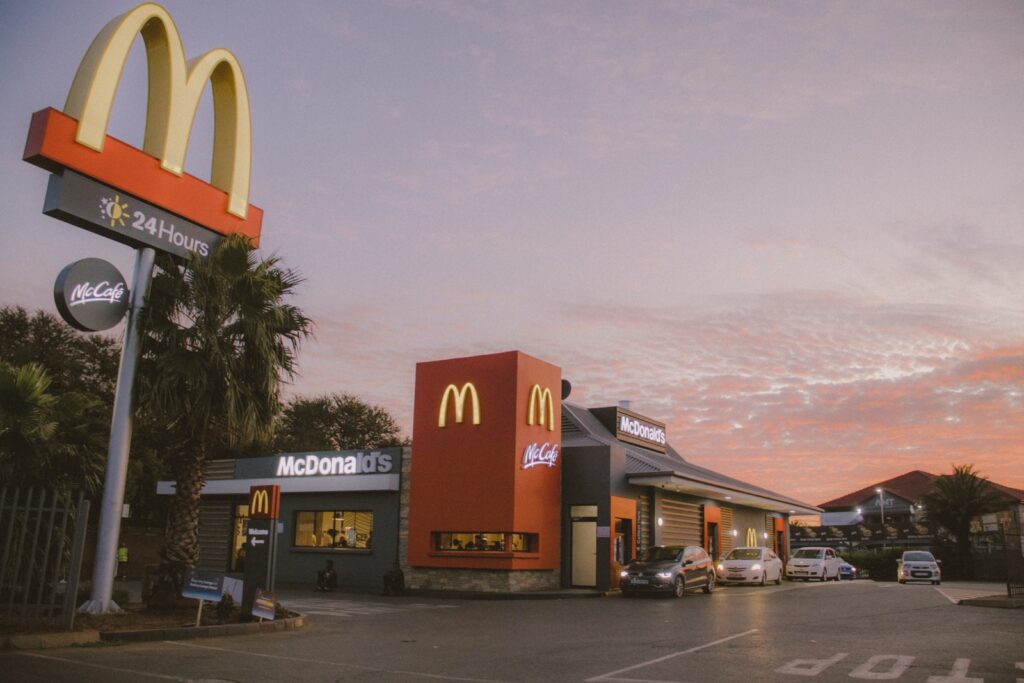
McDonald’s
Did you know McDonald’s removed salads from its menu in response to the pandemic in April 2020? Until those come back, here are the best options:
Breakfast
- Fruit and Maple Oatmeal (320 calories)
- McCafe Americano or Latte with skim milk (0 calories, 57 calories)
- Plain egg McMuffin (290 calories)
Lunch
Literally all you can pick here are burgers or fries. There are not even grilled chicken sandwiches anymore. So McDonald’s would be a good “20” meal. And it doesn’t have to be so expensive in calories. A regular cheeseburger with a kid’s-size of fries is 410 calories. Just try to avoid “supersizing” even if it is only 20 cents extra.
Subway
Most of the 6-inch subs at Subway are relatively low in calories. Although it is delicious, the classic Tuna is drenched in mayonnaise and therefore calories, so you probably want to steer clear of that and the double meat sandwich. Same with the sides of chips or cookies.
The healthiest options at Starbucks are:
- Protein Bowl—Cold Cut Combo, Black Forest Ham, or Oven Roasted Chicken. Add any and all veggies (even pickles). Red wine and/or regular or spice mustard for dressing (about 350-400 calories per bowl). Avoid the honey mustard or mayo-based sauces.
- 6-inch Turkey or Oven Roasted Chicken Sub on wheat roll. Add swiss cheese (their serving size only adds about 50 calories), lettuce, tomato, cucumber, and purple onion, red wine vinegar and mustard. Or make it a footlong and eat it over two lunches (350-400 calories per sandwich).
Wendy’s
- Southwest Avocado Chicken Salad, no dressing or BYOD (440 calories)
- Apple Pecan Chicken Salad, no dressing or BYOD (340 calories)
With all the smashed avocado in the Southwest Salad, and the Blue Cheese in the Apple Pecan you don’t really need to use the dressing. This way you keep your lunch under 500 calories.
Panera
The Modern Caprese Sandwich of Panera Bread is deceptively unhealthy, so definitely avoid that and most of the pasta dishes and pastries.
- Low-fat Chicken Noodle Soup (160 calories) (notice you can buy these in grocery stores)
- Sprouted Grain Bagel (180 calories)
- Asian Sesame Salad (410 calories)
“Build a Bowl” Places
Bowls To-go: CAVA, BibiBOP, Roti
Nutrition facts:
All these places have a formula perfect for the LBD method: you choose a base, protein, veggie, fat, dressing, and then pay at least 20 dollars.
For lunch, going to a place where you can conveniently customize is key. For example, here is what you should order at a “bowl”
- Base of greens (spinach, kale, arugula)
- One whole grain: quinoa, brown rice, or wild rice, root vegetables (sweet potato or carrot)
- Protein: chicken, shrimp, or beans if vegetarian
- Veggies: cucumbers, carrots, tomatoes, celery, bell pepper (pickled veggies also give a sour taste if that’s what you are in the mood for)
- ONE of cheese, olives, seeds or avocado as a fat: parmesan crisps, goat cheese, avocado or shaved parmesan
- Plain balsamic vinegar or red wine vinegar or BYOD
For sauces, if it is a mediterranean type place, I like shug or harissa sauce, which is spicy, and tzatziki sauce which, contrary to most beliefs, is actually low calorie. Anything yogurt or chili based is generally a good choice. You can also take advantage of their perfectly sliced lemons and limes to add more flavor by asking for a lime or lemon squeeze.
I prefer to get my carbs from the grains rather than the side bread option, as I usually don’t know whether the bread has whole grains and will be a fibrous carb choice.
Try to stay away from salami-type meats and heavy cheeses like cheddar or mozzarella. They are fine, but they usually give too much in portions.
Chipotle
It goes without saying, but generally you want to avoid the chips, quesadillas, burritos and tacos because the flour tortillas are cooked with a lot of heavy oils and the toppings in these include a lot of sour cream, rice, and guacamole which can really inflate the calorie and fat count.
The best option at Chipotle is the Chicken Burrito Bowl. If you use your own salad greens, you can stretch a burrito bowl over two lunches. Any of their salads with steak, beans or chicken are also healthy options, as long as you get the right toppings. If you get a salad bowl, get it with greens, brown rice, chicken, salsa, and guacamole on the side. Make sure you eat a golf ball size’s worth, because the serving chipotle gives can be as much as a whole avocado, which is a whopping 250 calories on its own. This way, your meal will be only about 350 calories and have a lot of healthy PFC in it.
Convenience stores, CVS, Walgreens
Look, we all have to pop into a gas station or a random strip mall every once in a while to grab a bite. If you know you will be running around or driving for a few hours, try to eat a meal or snack before leaving the house. Otherwise, the shopping will make you hungrier and more likely to make poor food choices.
If you need to stop at a convenience place, don’t just wander the aisles and stare at the food (I see this all the time). Have an “LBD” option for these places.
For example, my go-to LBD for these places is something I know I can get in all of them, which I would recommend:
- Nuts
- Fruit cups
- Dried fruit (dates, apricots, prunes, mango) (just watch for the added sugar)
- Whole wheat crackers and string cheese
- Baby carrots (usually)
- Kind Bars
- Dark chocolate (look for at least 55% cacao)
- Popchips (not exactly “healthy” but a nice crunchy salty alternative to the chips)
- Yogurt (usually Chobani Dannon, or Fage are available)
What if I am vegan?
Good news! There is a whole website dedicated to ordering vegan anywhere, including many of the places I am about to list below: https://veggl.com/

